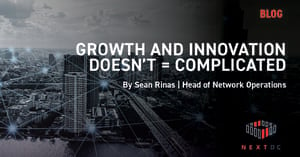Written by: Sean Rinas, Head of Network Operations
Albert Einstein once said, “The measure of intelligence is the ability to change”. In current circumstances, remote working is the ‘new black’. The need for capacity is surging for many organisations, as is the ability to adjust critical systems and infrastructure deployments. Connectivity, to local public services such as the Cloud, is paramount to business continuity.
It’s a new world. There are millions of people across Australia who are accessing the systems and tools they need to perform their employment roles from home. There’s equally an inordinate number of students distance learning alongside cooped-up households looking for online entertainment options.
Organisations of all sizes are using more data, demand for Government services has sky-rocketed and a socially distanced population is using entertainment and social platforms significantly more.
So it comes as no surprise that we are stretching the limits of what our existing public and private digital infrastructure can manage. Even the most innovative, agile organisations – those that have advanced digital transformation strategies and those that only emerged in the cloud era – are having to rapidly adapt to today’s social distancing and business continuity imperatives.
With challenges in supply chains, the demand for increased capacity is manifesting in rising demand for the flexible, scalable services facilitated by public cloud platforms such as those available from AWS, Google and Microsoft.
This of course makes perfect sense. Public cloud platforms offer secure, resilient and scalable high-density computing capacity on tap.
Even before the current situation, the growth in cloud services was phenomenal. A Boston Consulting Group report from October 2019 found that the Australian public cloud services market was worth $4.6 billion per year with a compound annual growth rate (CAGR) of 24%. At the time the BCG report was published, public cloud represented 9% of the total IT spend in the country.
You can be sure that those numbers are obsolete as the result of this global pandemic. The recent reports involving the growth of collaborative and video-conferencing platforms as remote teams find new ways to stay connected are mind blowing.
Forbes reported a 775% increase in Microsoft Teams usage, while the Zoom video-conferencing platform experienced a staggering 2000% growth from users all over the world. Engagement with the world’s leading cloud platforms is also surging, so that groan you hear is our public telecoms infrastructure working harder than ever before under the strain of increased demand.
At NEXTDC, we’re seeing a surge in demand for direct connections to the leading cloud platforms.
Clearly, as the demand for cloud capacity increases, the cost, performance and efficiency benefits of direct connection become ever more compelling. Prior to today, many organisations were still using public infrastructure to get to the clouds that they now need more than ever.
The current landscape has forced the need for an urgent rethink of hybrid architecture and Multi-Cloud connectivity. Risk management, redundancy, uptime and disaster recovery have never been more important. While this represents short-term challenges, it is also a pivotal moment that is sure to introduce a range of long-term benefits as organisations adapt to new digital platform models that have been re-engineered to embrace the concepts of flexibility, agility and high availability.
Organisations are now rapidly deploying more resources to meet the changing circumstances which is exactly the value derived from Hybrid Cloud. At the heart of adapting to this new world is direct connectivity from private infrastructure to public cloud infrastructure, where resources are immediately available at the scale, speed and performance required.
There are many benefits from using direct connectivity to optimise Hybrid Cloud architectures and increasingly distributed environments. They respond quickly to changes in demand, competition profiles or environmental conditions where agility is crucial and they enable organisations to be more flexible in the way they accelerate strategy when new systems, people, solutions or urgent DevOps workloads need to be quickly added.
As demand for IT infrastructure increases, organisations need versatility and agility to ensure their teams, partners and customers don’t experience performance degradation. With the significant additional traffic on public carrier networks, it’s a very real possibility that your commercial Cloud services are compromised if they are occurring over the public internet.
The use of physically diverse interfaces provides a multiplying effect on the uptime for these services. Organisations that adopt privatised, direct connectivity strategies for workloads puts them in an optimal position to guarantee consistent and stable connections to the critical services they rely on. In addition, the use of physically diverse interfaces provides a multiplying effect on the uptime for these services.
This performance improvement comes courtesy of having shorter paths to the clouds with less hops, and therefore fewer potential points of failure and less latency. At the same time, private and secure connections relieve pressure from the public infrastructure which causes a cascading benefit for other services delivered through the internet.
We all need to be resourceful in the way we attack the challenges of the present and prepare for a future that is largely unknown. When it comes to staying connected to each other in a disrupted economy, direct access to public clouds over privatised infrastructure could be the intelligent change that Einstein was referring to.
Einstein also noted, “Logic will get you from A to Z; imagination will get you everywhere.” Right now, we need creativity and innovation more than ever.
If we can help you stay connected to the platforms, people and organisations that keep your team functioning, please reach out. We’re here to help.


